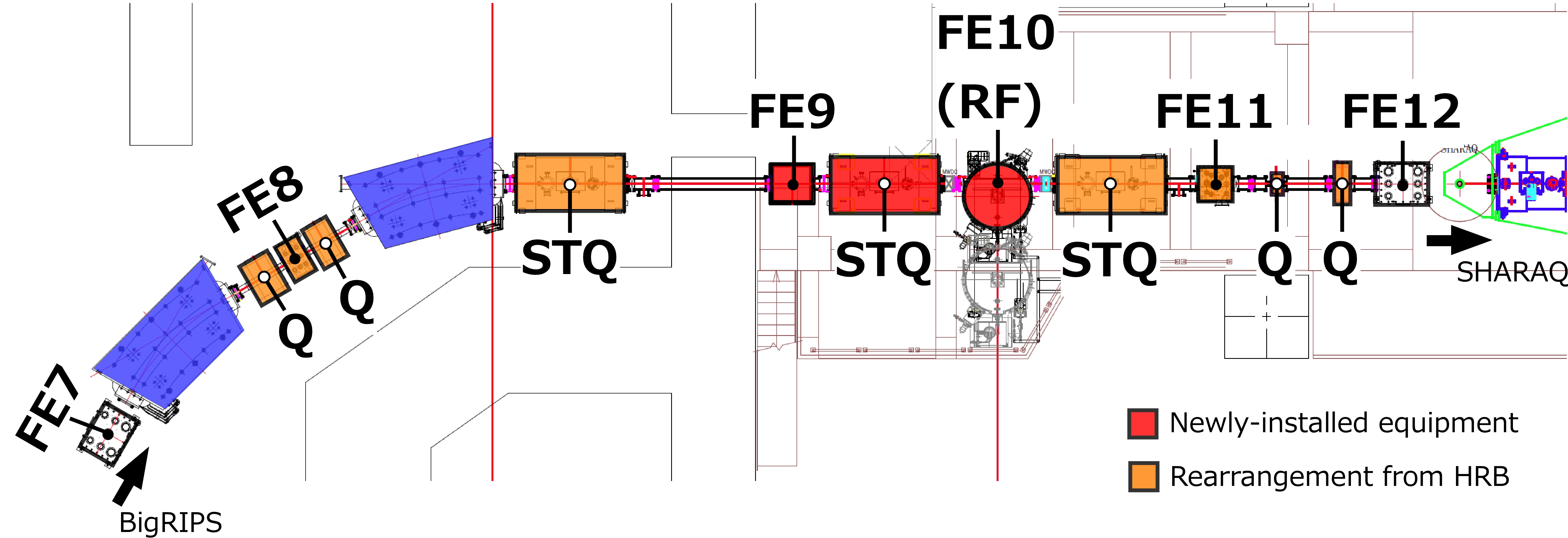Technical Information のバックアップ(No.16)
- バックアップ一覧
- 差分 を表示
- 現在との差分 を表示
- 現在との差分 - Visual を表示
- ソース を表示
- Technical Information へ行く。
- 1 (2015-07-28 (火) 17:48:27)
- 2 (2015-07-28 (火) 18:02:24)
- 3 (2015-07-29 (水) 15:43:06)
- 4 (2015-07-30 (木) 01:40:20)
- 5 (2015-07-30 (木) 02:01:31)
- 6 (2015-07-30 (木) 11:21:35)
- 7 (2015-07-30 (木) 14:45:11)
- 8 (2015-07-30 (木) 15:54:21)
- 9 (2015-07-31 (金) 11:30:03)
- 10 (2015-08-06 (木) 20:11:24)
- 11 (2015-09-02 (水) 18:20:45)
- 12 (2015-09-02 (水) 18:24:44)
- 13 (2015-09-17 (木) 11:01:22)
- 14 (2017-07-28 (金) 13:17:44)
- 15 (2017-07-28 (金) 17:51:57)
- 16 (2017-07-28 (金) 19:18:54)
- 17 (2017-07-28 (金) 20:16:15)
Beam-line configuration
OEDO project is an upgrade of the beamline which is currently operated as "High-Resolution Beam-line" in RIBF. In March, 2017, new devices of a STQ (Superconduting Triplet Quadrupole magnet) and an RF-deflector were installed. The almost part of OEDO beamline was completed by rearrangement of existing beamline devices. The commissioning of the OEDO beamline was performed in June, 2017.
The OEDO beamline shares the elements with BigRIPS from F0 to F6. The elements of OEDO after F6 are listed below and the OEDO beamline finally gets connected to the SHARAQ spectrometer.
| F0 - F6 | BigRIPS |
| QQQ - QQQ | |
| FE7 | Vacuum chamber for beam monitor |
| D - Q | |
| FE8 | Dispersive focus |
| Q - D - QQQ | |
| FE9 | Dispersive focus for an energy degrader |
| QQQ | |
| FE10 | RF deflector |
| QQQ | |
| FE11 | Achromatic focus |
| QQQ | |
| FH12/S0 | Achromatic focus |
| SHARAQ spectrometer | |
| S2 | Focus for measurements of outgoing particles |
Acceptance and transmission
Based on the preliminary report of the commissioning results, we provide the transmission of the OEDO beamline. As conditions of the secondary beam, the momentum was set to be ± 1%, the spot size at BigRIPS F3 was 10 mm in diameter. The transmission of the secondary beam to the secondary target position (S0) was preliminarily estimated to be 10%.
Intensity estimation for your proposals
The secondary beam production provided by OEDO is still under development. However, we would advise that beam intensity from OEDO is estimated under the following conditions:
- Momentum acceptance : ± 1%,
- Spot size at F3 : smaller than 10mm diameter,
- Angular acceptance at F3 : smaller than 10mrad(H) and 20mrad(V),
- Transmission to the secondary target: 10%,
which is based on the preliminary information on the commissioning.
You are able to estimate numerically the secondary beam intensity at F3 which satisfy the above conditions 1-3 by using a simulation code such as LISE++. 10% of the value is a rough indication of beam intensity at S0.
Note that we are not able to assure the estimated intensities,
since each experimental condition is not absolutely under control.
If you are strongly interested in the development of OEDO-SHARAQ and fervently wish to make experiments, we are always welcome research collaborations with you for increasing beam intensities and for performing physical experiments.
This web page will be updated accompanying with development of OEDO. When you urgently hope information on OEDO-SHARAQ system, you are able to contact to Prof. N.Imai (n.imai_at_cns.s.u-tokyo.ac.jp).
 ホーム
ホーム 一覧
一覧 単語検索
単語検索 最終更新
最終更新 ヘルプ
ヘルプ